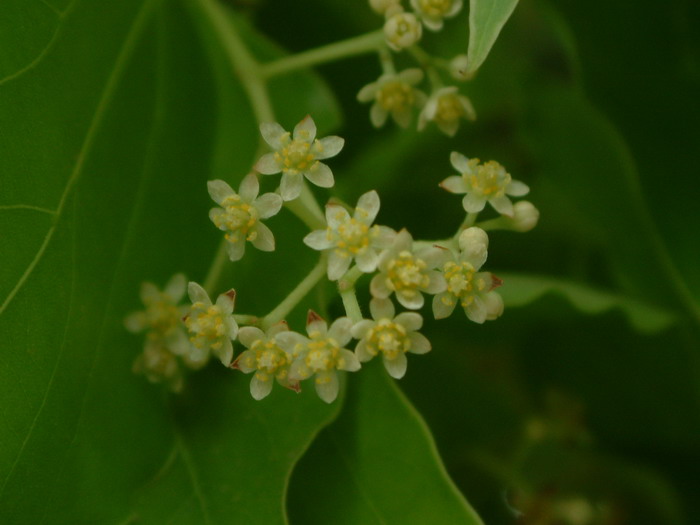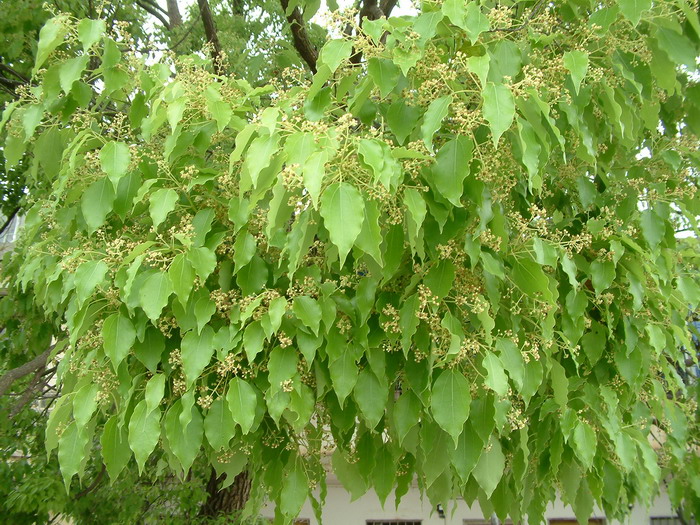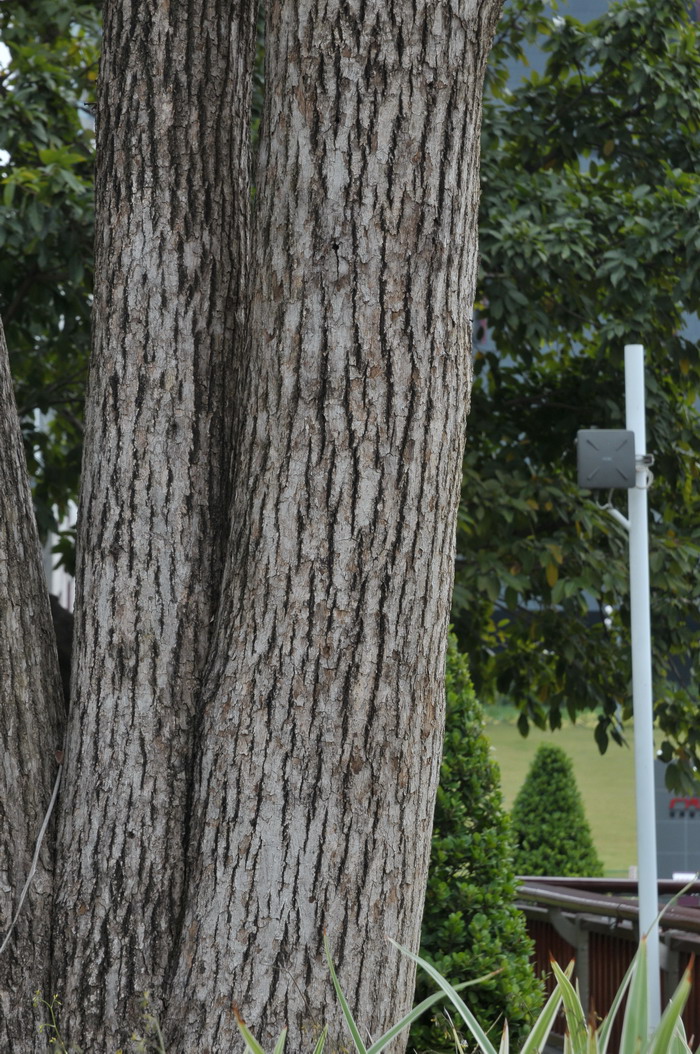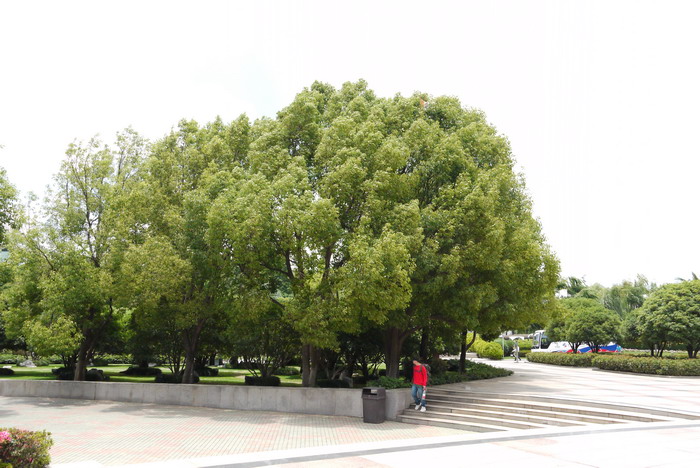樟树Cinnamomum camphora
中文名(Chinese Name):樟树
学名(Scientific Name):Cinnamomum camphora (L.) J. Presl
英文名(English Common Name):camphortree
别名(Chinese Common Name):
异名(Synonym):Camphora camphora (L.) Karst. Camphora vera Raf. Camphorina camphora (L.) Farw. Camphora hahnemannii Lukman. Camphora hippocratei Lukman. Cinnamomum camphora f. linaloolifera (Y.Fujita) Sugim. Cinnamomum camphora f. parvifolia Miq. Cinnamomum camphora var. cyclophyllum Nakai Cinnamomum camphora var. hosyo (Hatus.) J.C.Liao Cinnamomum camphora var. rotundifolia Makino Cinnamomum camphoriferum St.-Lag. Cinnamomum officinarum Nees ex Steud. Laurus camphorifera Salisb. Ocotea japonica (Garsault) Thell. Persea camfora Spreng.
科属(Family & Genus):樟科(Lauraceae)樟属
形态特征(Description):常绿大乔木,高可达30米,直径可达3米,树冠广卵形;枝、叶及木材均有樟脑气味;树皮黄褐色,有不规则的纵裂。顶芽广卵形或圆球形,鳞片宽卵形或近圆形,外面略被绢状毛。枝条圆柱形,淡褐色,无毛。叶互生,卵状椭圆形,长6-12厘米,宽2.5-5.5厘米,先端急尖,基部宽楔形至近圆形,边缘全缘,软骨质,有时呈微波状,上面绿色或黄绿色,有光泽,下面黄绿色或灰绿色,晦暗,两面无毛或下面幼时略被微柔毛,具离基三出脉,有时过渡到基部具不显的5脉,中脉两面明显,上部每边有侧脉1-3-5(7)条.基生侧脉向叶缘一侧有少数支脉,侧脉及支脉脉腋上面明显隆起下面有明显腺窝,窝内常被柔毛;叶柄纤细,长2-3厘米,腹凹背凸,无毛。圆锥花序腋生,长3.5-7厘米,具梗,总梗长2.5-4.5厘米,与各级序轴均无毛或被灰白至黄褐色微柔毛,被毛时往往在节上尤为明显。花绿白或带黄色,长约3毫米;花梗长1-2毫米,无毛。花被外面无毛或被微柔毛,内面密被短柔毛,花被筒倒锥形,长约1毫米,花被裂片椭圆形,长约2毫米。能育雄蕊9,长约2毫米,花丝被短柔毛。退化雄蕊3,位于最内轮,箭头形,长约1毫米,被短柔毛。子房球形,长约1毫米,无毛,花柱长约1毫米。果卵球形或近球形,直径6-8毫米,紫黑色;果托杯状,长约5毫米,顶端截平,宽达4毫米,基部宽约1毫米,具纵向沟纹。花期4-5月,果期8-11月。
分布(Distribution):产南方及西南各省区。常生于山坡或沟谷中。越南、朝鲜、日本也有分布。
用途(Use):木材及根、枝、叶可提取樟脑和樟油,樟脑和樟油供医药及香料工业用。果核含脂肪,含油量约40%,油供工业用。根、果、枝和叶入药,有祛风散寒、强心镇痉和杀虫等功能。木材又为造船、橱箱和建筑等用材。
引自植物志英文版:FOC Vol. 7 Page 102, 167, 175
Cinnamomum camphora (Linnaeus) J. Presl in Berchtold & J. Presl, Prir. Rostlin. 2(2): 36. 1825.
樟 zhang | Lauraceae | Cinnamomum
Laurus camphora Linnaeus, Sp. Pl. 1: 369. 1753; Camphora officinarum Nees; C. officinarum var. glaucescens A. Braun; Cinnamomum camphora var. glaucescens (A. Braun) Meisner; C. camphora var. nominale Hayata; C. camphoroides Hayata; C. nominale (Hayata) Hayata; C. simondii Lecomte; C. taquetii H. Léveillé; Persea camphora (Linnaeus) Sprengel.
Evergreen large trees, up to 30 m tall, to 3 m d.b.h.; corona broadly ovate; whole plant strongly camphor-scented. Bark yellow-brown, irregularly and longitudinally fissured. Branchlets brownish, terete, glabrous. Terminal buds broadly ovoid; bud scales broadly ovate or suborbicular, sparsely sericeous outside. Leaves alternate; petiole slender, 2-3 cm, concave-convex, glabrous; leaf blade yellow-green or gray-green and glaucous abaxially, green or yellow-green and shiny adaxially, ovate-elliptic, 6-12 × 2.5-5.5 cm, subleathery, glabrous on both surfaces or sparsely puberulent abaxially only when young, triplinerved or sometimes inconspicuously 5-nerved, midrib conspicuous on both surfaces, lateral veins 1-5(-7) pairs, basal veins with a few additional veins outside, axils of lateral veins and veins conspicuously dome-shaped and always villous abaxially, conspicuously bullate adaxially, base broadly cuneate or subrounded, margin cartilaginous, entire or sometimes undulate, apex acute. Panicle axillary, 3.5-7 cm; peduncle 2.5-4.5 cm, peduncle and rachis glabrous or gray- to yellow-brown puberulent especially on node. Pedicels 1-2 mm, glabrous. Flowers green-white or yellowish, ca. 3 mm. Perianth glabrous or puberulent outside, densely pubescent inside; perianth tube obconical, ca. 1 mm; perianth lobes elliptic, ca. 2 mm. Fertile stamens 9, ca. 2 mm; filaments pubescent. Ovary ovoid, ca. 1 mm, glabrous; style ca. 1 mm. Fruit purple-black, ovoid or subglobose, 6-8 mm in diam.; perianth cup in fruit cupuliform, ca. 5 mm, longitudinally sulcate, base ca. 1 mm wide, apex truncate and up to 4 mm wide. Fl. Apr-May, fr. Aug-Nov.
Cultivated in valleys and on mountain slopes. S of Chang Jiang river on mainland, Taiwan [Japan, Korea, Vietnam; introduced or cultivated in many countries around the world].
This species is the main source of camphor, which is derived from chipped wood of the stems and roots and also from branchlets and leaves by steam distillation. It contains a fixed volatile oil. The plant is used medicinally as a stimulant, antispasmodic, antiseptic, and rubefacient. It also is used in the manufacture of celluloid. The wood is beautifully grained, light brownish, easily polished, and used for furniture, cabinets, and interior finish in buildings.




 (责任编辑:徐晔春)
(责任编辑:徐晔春)
学名(Scientific Name):Cinnamomum camphora (L.) J. Presl
英文名(English Common Name):camphortree
别名(Chinese Common Name):
异名(Synonym):Camphora camphora (L.) Karst. Camphora vera Raf. Camphorina camphora (L.) Farw. Camphora hahnemannii Lukman. Camphora hippocratei Lukman. Cinnamomum camphora f. linaloolifera (Y.Fujita) Sugim. Cinnamomum camphora f. parvifolia Miq. Cinnamomum camphora var. cyclophyllum Nakai Cinnamomum camphora var. hosyo (Hatus.) J.C.Liao Cinnamomum camphora var. rotundifolia Makino Cinnamomum camphoriferum St.-Lag. Cinnamomum officinarum Nees ex Steud. Laurus camphorifera Salisb. Ocotea japonica (Garsault) Thell. Persea camfora Spreng.
科属(Family & Genus):樟科(Lauraceae)樟属
形态特征(Description):常绿大乔木,高可达30米,直径可达3米,树冠广卵形;枝、叶及木材均有樟脑气味;树皮黄褐色,有不规则的纵裂。顶芽广卵形或圆球形,鳞片宽卵形或近圆形,外面略被绢状毛。枝条圆柱形,淡褐色,无毛。叶互生,卵状椭圆形,长6-12厘米,宽2.5-5.5厘米,先端急尖,基部宽楔形至近圆形,边缘全缘,软骨质,有时呈微波状,上面绿色或黄绿色,有光泽,下面黄绿色或灰绿色,晦暗,两面无毛或下面幼时略被微柔毛,具离基三出脉,有时过渡到基部具不显的5脉,中脉两面明显,上部每边有侧脉1-3-5(7)条.基生侧脉向叶缘一侧有少数支脉,侧脉及支脉脉腋上面明显隆起下面有明显腺窝,窝内常被柔毛;叶柄纤细,长2-3厘米,腹凹背凸,无毛。圆锥花序腋生,长3.5-7厘米,具梗,总梗长2.5-4.5厘米,与各级序轴均无毛或被灰白至黄褐色微柔毛,被毛时往往在节上尤为明显。花绿白或带黄色,长约3毫米;花梗长1-2毫米,无毛。花被外面无毛或被微柔毛,内面密被短柔毛,花被筒倒锥形,长约1毫米,花被裂片椭圆形,长约2毫米。能育雄蕊9,长约2毫米,花丝被短柔毛。退化雄蕊3,位于最内轮,箭头形,长约1毫米,被短柔毛。子房球形,长约1毫米,无毛,花柱长约1毫米。果卵球形或近球形,直径6-8毫米,紫黑色;果托杯状,长约5毫米,顶端截平,宽达4毫米,基部宽约1毫米,具纵向沟纹。花期4-5月,果期8-11月。
分布(Distribution):产南方及西南各省区。常生于山坡或沟谷中。越南、朝鲜、日本也有分布。
用途(Use):木材及根、枝、叶可提取樟脑和樟油,樟脑和樟油供医药及香料工业用。果核含脂肪,含油量约40%,油供工业用。根、果、枝和叶入药,有祛风散寒、强心镇痉和杀虫等功能。木材又为造船、橱箱和建筑等用材。
引自植物志英文版:FOC Vol. 7 Page 102, 167, 175
Cinnamomum camphora (Linnaeus) J. Presl in Berchtold & J. Presl, Prir. Rostlin. 2(2): 36. 1825.
樟 zhang | Lauraceae | Cinnamomum
Laurus camphora Linnaeus, Sp. Pl. 1: 369. 1753; Camphora officinarum Nees; C. officinarum var. glaucescens A. Braun; Cinnamomum camphora var. glaucescens (A. Braun) Meisner; C. camphora var. nominale Hayata; C. camphoroides Hayata; C. nominale (Hayata) Hayata; C. simondii Lecomte; C. taquetii H. Léveillé; Persea camphora (Linnaeus) Sprengel.
Evergreen large trees, up to 30 m tall, to 3 m d.b.h.; corona broadly ovate; whole plant strongly camphor-scented. Bark yellow-brown, irregularly and longitudinally fissured. Branchlets brownish, terete, glabrous. Terminal buds broadly ovoid; bud scales broadly ovate or suborbicular, sparsely sericeous outside. Leaves alternate; petiole slender, 2-3 cm, concave-convex, glabrous; leaf blade yellow-green or gray-green and glaucous abaxially, green or yellow-green and shiny adaxially, ovate-elliptic, 6-12 × 2.5-5.5 cm, subleathery, glabrous on both surfaces or sparsely puberulent abaxially only when young, triplinerved or sometimes inconspicuously 5-nerved, midrib conspicuous on both surfaces, lateral veins 1-5(-7) pairs, basal veins with a few additional veins outside, axils of lateral veins and veins conspicuously dome-shaped and always villous abaxially, conspicuously bullate adaxially, base broadly cuneate or subrounded, margin cartilaginous, entire or sometimes undulate, apex acute. Panicle axillary, 3.5-7 cm; peduncle 2.5-4.5 cm, peduncle and rachis glabrous or gray- to yellow-brown puberulent especially on node. Pedicels 1-2 mm, glabrous. Flowers green-white or yellowish, ca. 3 mm. Perianth glabrous or puberulent outside, densely pubescent inside; perianth tube obconical, ca. 1 mm; perianth lobes elliptic, ca. 2 mm. Fertile stamens 9, ca. 2 mm; filaments pubescent. Ovary ovoid, ca. 1 mm, glabrous; style ca. 1 mm. Fruit purple-black, ovoid or subglobose, 6-8 mm in diam.; perianth cup in fruit cupuliform, ca. 5 mm, longitudinally sulcate, base ca. 1 mm wide, apex truncate and up to 4 mm wide. Fl. Apr-May, fr. Aug-Nov.
Cultivated in valleys and on mountain slopes. S of Chang Jiang river on mainland, Taiwan [Japan, Korea, Vietnam; introduced or cultivated in many countries around the world].
This species is the main source of camphor, which is derived from chipped wood of the stems and roots and also from branchlets and leaves by steam distillation. It contains a fixed volatile oil. The plant is used medicinally as a stimulant, antispasmodic, antiseptic, and rubefacient. It also is used in the manufacture of celluloid. The wood is beautifully grained, light brownish, easily polished, and used for furniture, cabinets, and interior finish in buildings.
踩一下[0]

顶一下[5]